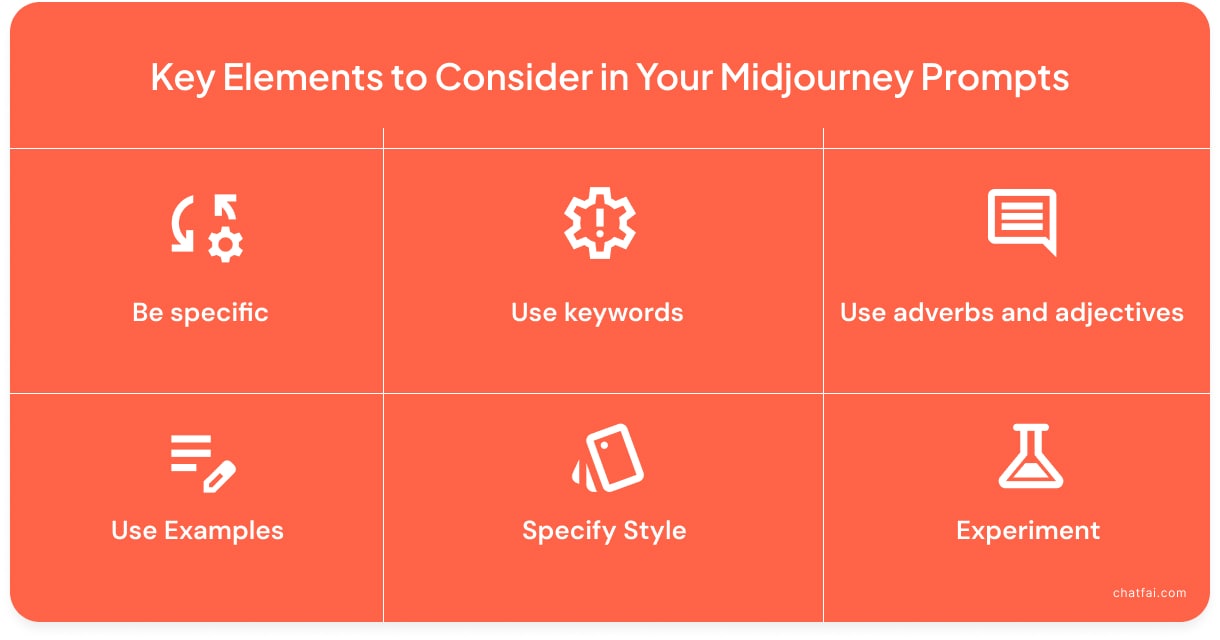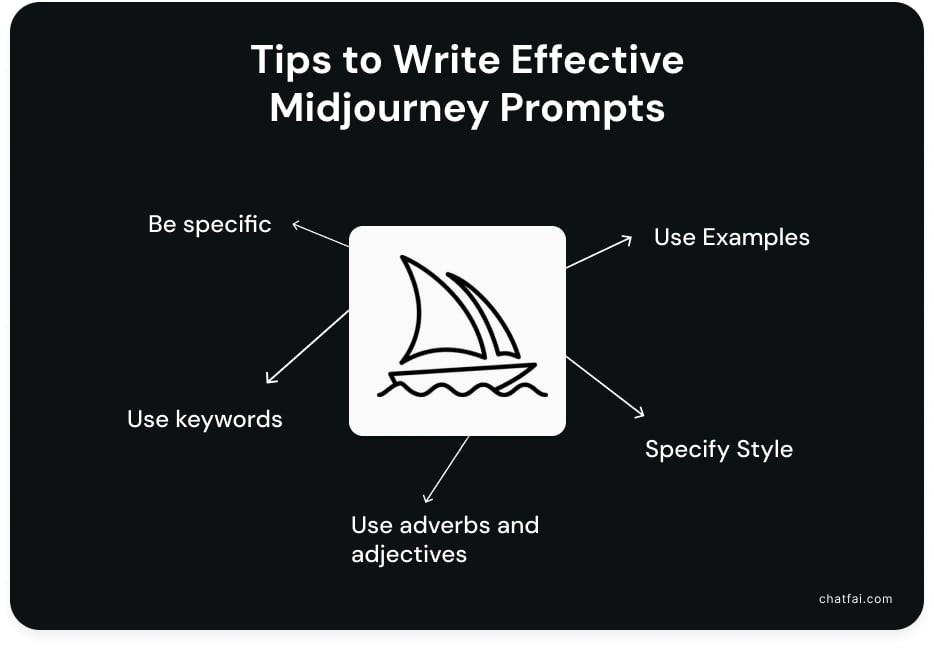Seeing your imagination turn into reality feels surreal, doesn’t it? It sounds like a fantasy! However, with tools like Midjourney, it’s not just a fantasy anymore.
Midjourney is an AI tool that lets users seek creativity through words. The magic lies in prompts. The more effective your prompt is, the more targeted and desired results you’ll get. Learning how to write an effective Midjourney prompt is the goal, right?
The blog post will guide you on how to write effective Midjourney prompts. But first, let’s get an overview of the platform.
Understanding Midjourney
Midjourney, developed under David Holz’s direction, is a state-of-the-art generative AI application and service that creates visually appealing images from natural language descriptions. Like DALL-E from OpenAI and Stable Diffusion from Stability AI, Midjourney has become well-known for its capacity to produce excellent graphics from straightforward text-based instructions.
Users can use particular commands to communicate with a bot on Midjourney through Discord, prompting the bot to make graphics. Midjourney image generator is based on Diffusion models and LLM that understand the prompts. By translating the text instructions into numerical vectors that direct the diffusion process, the large language model helps to comprehend the text prompts. Pretty straightforward, isn’t it?
Since we have pretty much knowledge of how the tool works, it’s time to decode the prompt mechanism.
Midjourney Prompt Mechanism
The Midjourney Bot generates an image using a brief text phrase called Prompt. To create an image, the Midjourney Bot divides a prompt’s words and sentences into smaller units called tokens, then compared to its training set.
Every prompt starts with the word imagine. In addition to this basic rule of thumb, here’s another one: every Midjourney prompt comprises two basic elements;
- < /imagine >
- Sample image URL (optional)
- A text prompt
- Parameters (optional)
A well-written prompt might help produce original and captivating photos. So, it’s all about the prompt. The more sophisticated your prompt, the more likely you’ll get the desired results.
Your prompt can be as simple as “a moon shining over the sea beside a hill, so it seems there are three moons together” to as complex as possible.
Therefore, learning the prompt mechanism is the need of the hour to unlock the full potential of Midjourney.
Pro Tip: Want some help in generating prompts? Here are some ChatGPT prompts for getting tailored images.
Types of Prompts
We can divide the prompts into simple and advanced prompts.
1. Simple Prompt
A simple prompt does not contain image URLs or parameters. You can design simple pictures using this prompt.
/imagine [ A rabbit eating a carrot on Mount Everest in the style of Picasso]
2. Advanced Prompt

However, if you want to go the extra mile to ignite creativity in yourself, you can insert a sample image’s URL and define parameters.
< /imagine > + < image URLs > + < text prompt > + < –parameter1 –parameter2 >
6 Key Elements to Consider in Your Midjourney Prompts
Here are some key elements you must consider when giving a prompt to Midjourney:

1. Be Specific
The more precise your request, the more likely Midjourney will produce an image that aligns with your idea.
Rather than writing “a cat,” for instance, you could write “a photorealistic portrait of a tabby cat with green eyes.”
2. Employ Keywords
Use keywords in your prompt writing to help Midjourney comprehend what you’re searching for.
For instance, you may use keywords like “cat,” “feline,” “whiskers,” and “paws” to get Midjourney to create an image of a cat.
3. Specify Style
Ensure to include keywords related to the style you want Midjourney to create for your image.
For example, you might enter keywords like “impressionism” and “Van Gogh” to have Midjourney produce an image in the manner of Vincent van Gogh.
4. Employ Adverbs and Adjectives
Using adjectives and adverbs can help your prompt have more specificity and description.
One possible example could be “a photorealistic portrait of a tabby cat with green eyes, sitting on a windowsill in the sunlight.”
5. Make Use of Examples
If possible, include examples to aid Midjourney in understanding your needs.
One possible example would be to write “a photorealistic portrait of a tabby cat that looks like this [URL link to an image of a tabby cat].”
6. Try. Experiment. Repeat
Don’t be scared to try out various prompts. Check what functions well and what doesn’t.
Writing successful Midjourney prompts will become second nature as you write more.
Decoding Midjourney Prompts
Midjourney follows the golden rule of “Simplicity.” Simple, brief statements clearly stating what you want to see are ideal for the Midjourney Bot to understand. However, you should steer clear of lengthy requests and instructions. Simple doesn’t mean BLAND. Use specific keywords in your Midjourney prompt to get the results you imagine.
Here is an example of a specific Midjourney prompt: Instead of saying: show me a photo of several flowering California poppies,” add details like “Make them a vivid orange and use colored pencils to describe the scene.”
At this point, it’s clear how you must write a simple yet effective prompt. Here are some more pieces of advice straight from the heart to rescue you.

For greater influence over the final photograph, ensure your prompt includes crucial components, including subject, media, environment, lighting, color, mood, and arrangement.
Lastly, keep your instructions brief and straightforward to get the best results, concentrating on the key ideas you want to see in your image.
Despite employing these tips to create an effective prompt, you often don’t get the desired results. Scroll down to learn how to write realistic Midjourney prompts.
How to Write Realistic Midjourney Prompts
To keep your picture looking REAL, use realistic keywords in your prompts. Here are some ways you can use realistic prompts;
1. Make Use of Realistic Keywords
Make careful to incorporate realistic-sounding keywords into your prompt writing. Use realistic keywords while writing Midjourney prompts. For example, you can utilize terms such as “photorealistic,” “detailed,” and “lifelike.”
2. Explain the Level of Desired Realism
Adverbs and adjectives can be used to convey the necessary level of realism.
For instance, “A photorealistic portrait of a tabby cat with green eyes, rendered in a hyper-realistic style” may be written.
3. Try Different Settings
Several parameters available in Midjourney can impact how realistic the visuals it creates are.
Try out several configurations to determine what suits you the best.
How to Write Effective Midjourney Prompt?
Writing an effective Midjourney prompt requires you to have a sound knowledge of the ins and outs of the tool. The above-mentioned tips are good for getting started. However, to write a prompt that shrieks, one must know these secret recipes for extra sausages.
Although a phrase or an emoji can produce an image using the bot’s default style, specific instructions provide more original outcomes. An in-depth prompt will provide the desired results rather than a dry and superficial prompt.
But here’s the caution!!! Stay away from complicated language and concentrate on the main points.
The second thing is to select precise synonyms to increase the impact of every word. For example, substitute the word “gigantic” for “big.” When feasible, remove unnecessary words.
The third and last one is to give extra importance to punctuation and grammar. It might sound weird, but it matters A LOT. Using commas, brackets, and hyphens might help you organize your thoughts more effectively, even though the Midjourney Bot does not understand grammar as humans do.
Recap
Here is a quick recap of how to write an effective Midjourney prompt: remember what you want to achieve through your output, keep it simple but in-depth, use clear language to instruct the AI, and add all necessary information.
You can also get help from ChatFAI chatbots to write effective Midjourney prompts that will give the desired results.
FAQs
Q: What Words Should I Use in Midjourney?
Use simple words, but be specific with what you want. Here are some tips for writing an effective prompt:
- Use specific keywords.
- Use adverbs and adjectives that best describe what you want.
- Don’t use complicated words.
- Be specific with the style you want.
Q: Can ChatGPT Generate a Midjourney Prompt?
Yes, you can ask ChatGPT to provide a prompt to get the best images from Midjourney. Provide relevant information to ChatGPT, and you can also tweak the prompt.
Q: How to Tweak Midjourney Results?
To tweak your Midjourney prompts, enable the Remix Mode to change your text prompt and parameters. This would help in changing image settings to get personalized results.
Q: How to Get Realistic Images on Midjourney?
It always starts with the prompt. Therefore, add information about lighting and frame, specify camera shot style, and use photographic style to create realistic images.